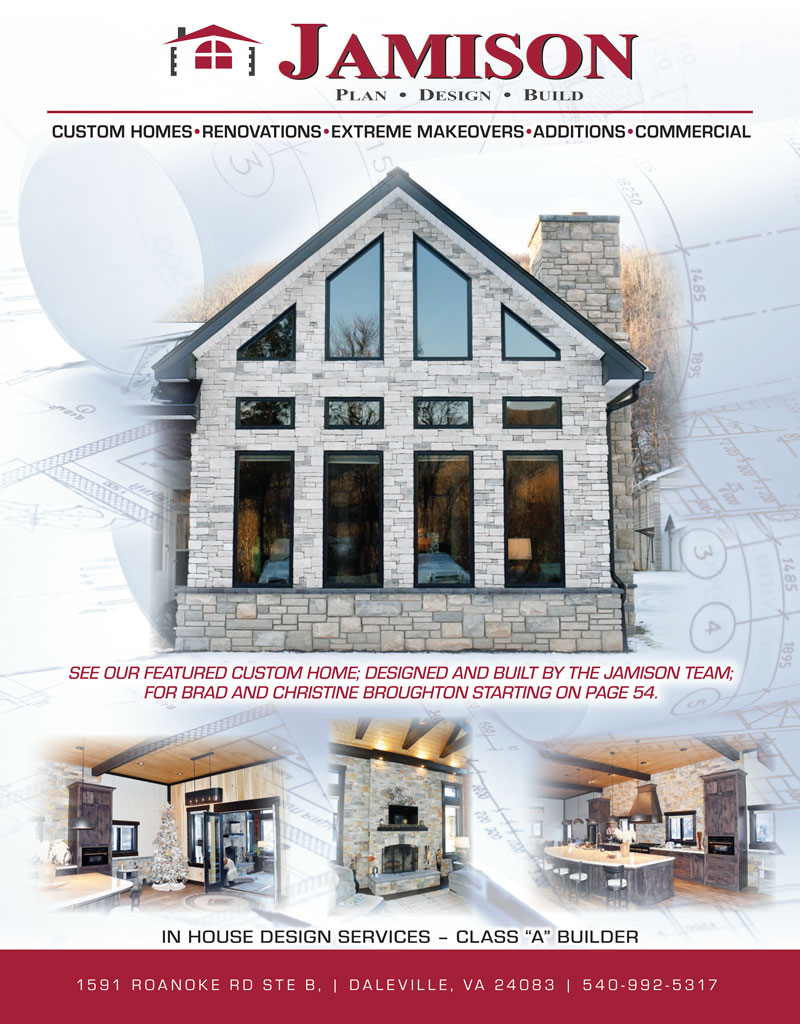Warm Up to Outdoor Living: Fireplaces and Heaters Can Make the Great Outdoors Even Greater


When the cold winds blow and fall gives way to winter, those backyard barbecues will have to wait until next year—or will they?
As outdoor living spaces evolve and new products and services become available, extending your time outdoors is more feasible than ever before, even in the winter months. Gather the family around a fire pit to roast marshmallows (and even sing some of those summer camp songs)! Or relax in front of a fireplace as you watch your steaks grill to perfection. Consider investing in a patio heater to give your holiday party guests a chance to get some fresh air outdoors.
If you’re not ready to give up on your patio time quite yet, here’s a guide to warming your outdoor areas.
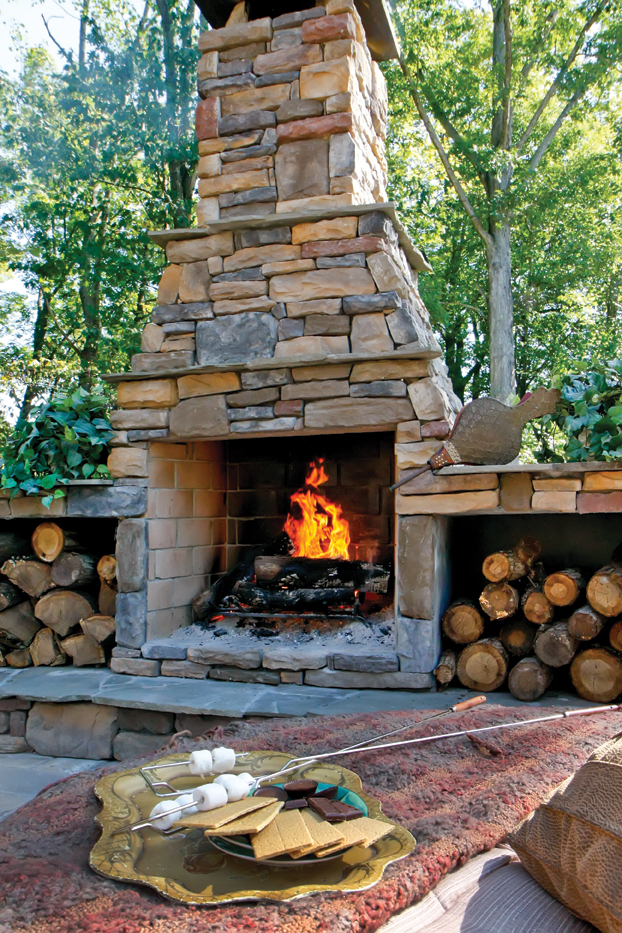
Outdoor Fireplaces
Brent Gleason of Boxley, a supplier of brick and stone products in Roanoke, said more people are putting money into hardscapes to enhance their home.
“We’re seeing in the building industry as a whole that people are building smaller homes, but nice homes, and using a lot of outdoor living areas.”
He said outdoor fireplaces, especially, are becoming a popular investment. “Some people use them all the time,” he said. “I think everybody that buys them puts them to use.”
Boxley offers more than 180 varieties of quality brick, lightweight cast stone veneers and natural stone products that can be picked up or delivered. Although Boxley works closely with architects, engineers and contractors for commercial and residential projects, they also assist DIYers with getting the best materials available for their home projects. They will help homeowners choose the product and give them printed how-to guides or help connect them directly with an area installer.
Many hardscape suppliers will also help coordinate your pre-existing features with a fireplace or fire pit. Boxley has an outdoor showroom with displays that are open 24/7 so customers can be inspired to create a custom outdoor living space.
For the eager homeowner ready to get started, there are even fireplace pre-fab kits. Boxley carries the FireRock systems, with some requiring only one day for installation. They come with precut pieces, with the customer choosing the veneer (man-made or natural) from a variety of colors and styles.
“They can be as simple or as fancy as you want them to be,” Gleason said.
Don Ballard of General Shale Brick says that their company manufactures its own real rock and clay-face brick that they cut a half-inch thick to use in veneering outdoor fireplaces and fire pits. Like Boxley, they also carry the popular FireRock outdoor fireplaces and fire pits. The kits can cost up to 50 percent less than the traditional masonry fireplace, Ballard said.
A fireplace opening (the firebox) can be arched or straight and is available in different widths, such as 30-, 36- or 42-inch. The buyer can extend the chimney height, if he prefers. There’s also the option of raising the hearth by putting it on a block base (providing more sitting room for guests) and adding a box opening for wood.
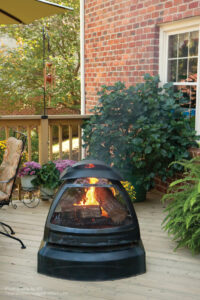 Fire Pits
Fire Pits
If you want a less permanent fixture, fire pits—or fire bowls or fire rings—may be an option for you. Fairly inexpensive, fire pits are catching on across the country, available in major retail stores. They come in limitless designs and shapes, from the typical round ones to a box (tabletop) or even pentagon, with decorative stone and tile. Some even have cutout characters or words so the fire’s glow can take on a personality of its own. Many come with unique stands and are easily portable, either lightweight or on wheels, so you can entertain at home or take the fun with you.
If you’re looking for warmth, the fire pit is your best bet. More people can enjoy it and easily move around it because of its design.
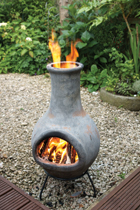 Chimineas
Chimineas
If you want to add style to your outdoor space, a chiminea, the old Mexican-style freestanding outdoor fireplace, is a great idea.
“After the traditional campfire, chimineas are probably the oldest kind of outdoor fire ‘appliance,’” according to the Hearth, Patio and Barbecue Association (HPBA). Dating back 400 years, the chiminea was once used regularly for cooking indoors, but now is often used outdoors to entertain on a deck or patio. Chimineas are the perfect conversation piece for your outdoor enjoyment.
Historically made of clay and raised on a stand, the small arched opening and slender chimney are available in many artistic designs incorporating decorative tile and stone. With more people using them outdoors, manufacturers have now turned to copper, cast iron and aluminum, because the typical clay varieties are unable to withstand the elements. These modern styles often have a screen to prevent the escape of stray sparks.
In the summertime, when heat isn’t the main goal, many people place a plant inside their chiminea or even candles to create a romantic setting.
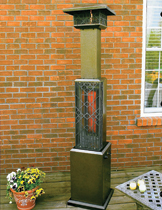 Patio Heaters
Patio Heaters
If you want pure heat, and the ambience of a fireplace is not necessary, patio heaters can do the job. Often the height of a lamp post, these appliances can “run on liquid propane or natural gas, produce 35,000 to 45,000 BTU’s and radiate heat 20 to 25 feet in all directions (farther than a firepit),” according to the HPBA. They come in stainless steel, cast aluminum, or painted steel and have domes on top; the larger the dome, the wider the distribution of heat.
The more basic models are portable, but you can also have them installed in the ground (and hooked up to a natural gas line) or choose a ceiling-mount model. Smaller “table-top” units are also available, producing up to 10,000 BTUs.
Patio heaters are an affordable option, ranging from about $300 to $700. A less expensive option is a simple spot heater. While patio heaters can disburse heat in a circle, spot heaters focus on one direction. If you have a more intimate setting, perhaps for one or two people, these electric models can do the job.
Location, Location
• Choose an area that is a safe distance from your house and outbuildings, as well as playsets.
• Make sure the area is clear of trees and cascading branches or vines, as well as roof overhangs.
• Keep fire bowls or rings on top of brick, concrete or block to keep from scorching decks or grass.
• Choose a level spot.
• Check for underground wires, cable or pipes.
• Since this will be a place to entertain and relax, make sure you allow for at least a three-foot distance between your seating area and the fire.
Resources
Need some inspiration? Check out these titles:
“Fire Outdoors: Fireplaces, Fire Pits, Wood-Fired Ovens & Cook Centers” (Schiffer),
by Tina Skinner and Melissa Cardona
“Fire Places: A Practical Design Guide to Fireplaces and Stoves Indoors and Out” (Taunton Press),
by Jane Gitlin
“The New Outdoor Kitchen: Cooking Up a Kitchen for the Way You Live and Play” (Taunton Press),
by Deborah Krasner
